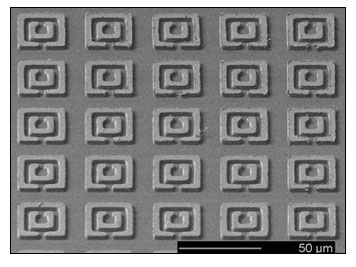SAN DIEGO, March 4 -- Scientists have developed a class of materials that respond magnetically to terahertz radiation, a fundamental finding relevant to many exciting applications in areas including guidance in zero visibility weather conditions, security and biomedical imaging and quality control. The materials are metamaterials -- artificially structured materials that extend the properties of existing, naturally occurring materials and compounds.
The research team includes physicists and engineers from the University of California, San Diego (UCSD); the University of California, Los Angeles; and Imperial College, London. In 2000, UCSD researchers created and reported the first measurements of left-handed metamaterials -- so-called because they reverse many of the physical properties that govern the behavior of ordinary materials. Left-handed materials were named one of the top ten scientific breakthroughs of the year in 2003 by Science, which is publishing the team's results (March 5), when these materials and their properties were independently confirmed by multiple groups. Although they're not left-handed, the new metamaterials demonstrate that the magnetic response can be extended to much higher frequencies -- namely the terahertz range, which lies between infrared and microwave bands along the electromagnetic spectrum.

MAGNETIC PERSONALITY: Scanning electron microscope image of the metamaterial. (Photo: Ta-Jen Yen)
"When we developed the initial left-handed materials that responded in the microwave range, we were not certain if it was technically feasible to develop materials that responded to higher frequencies," says David Smith, coauthor of the study and an associate adjunct professor in UCSD’s physics department. "This is a particularly exciting advance, because materials that respond in the terahertz range have many potential applications. There are very few natural materials that respond magnetically in the terahertz range."
Array on a Plate
The metamaterial is comprised of a 2-D array of repeated patterned copper elements, called split ring resonators, deposited on a quartz plate. Each split ring resonator is made up of two concentric copper squares, both having a small gap. The gap in the larger square is on the opposite side of the gap in the smaller square. The width of one of the split ring resonators is roughly 50 microns -- less than the thickness of a human hair.
The copper elements that make up these materials are analogous to atoms. Copper on its own is not magnetic, but the geometry of the resonator leads to an effective magnetic response, so the composite metamaterial can be characterized as magnetic. Therefore, these engineered metamaterials have properties that are not observed in their constituent materials.
"Designing terahertz or optical devices and components has many challenges," said Xiang Zhang, project leader and a UCAL professor of engineering and applied science. "Our work provides a new foundation for materials selection and device design, and we think it has the potential to enable an entirely new array of applications."
The original idea for left-handed composites came from Smith, building on the work of John Pendry, coauthor and a professor of physics at Imperial College. In 1996, Pendry theorized that certain configurations of metal can have unique responses to electric and magnetic fields. The Russian theorist V.G. Veselago initially predicted, in 1968, that materials which reverse physical properties -- such as the direction light bends when it passes through water, lenses and other ordinary materials -- might be possible.
According to the researchers, while terahertz scanners have great potential, up until now their uses have been limited because of the lack of inexpensive methods to generate and detect terahertz rays, or T-rays.
Imaging Potential
"Images taken using terahertz rays have good contrast between similar density objects," said Willie Padilla, a graduate student in the laboratory of UCSD physics professor Dimitri Basov, both coauthors of the paper. "So when building aircraft, terahertz scanners could be used to image aircraft components, even if the components were of similar densities," Padilla said. "Also, terahertz is useful for medical imaging and has the advantage that it is much less damaging than X-rays, because it consists of non-ionizing radiation."
Padilla said the Department of Defense is interested in terahertz because certain chemical and bioterror agents, like anthrax, happen to have a distinct absorption in the terahertz range, and since terahertz can penetrate clothing, it is also of interest for airport screening of weapons and explosives.
"Terahertz rays could also help pilots guide airplanes in foggy weather, because water doesn’t scatter terahertz rays at particular frequencies," he added.
The other researchers involved in this study were Ta-Jen Yen and Nicholas Fang, both graduate students in Zhang’s laboratory, and David C. Vier, an associate project scientist working with Smith. The study was part of a multidisciplinary university research initiative sponsored by the Defense Advanced Research Projects Agency through the Office of Naval Research and the US Army Research Office, as well as the National Science Foundation.
For more information, visit: physics.ucsd.edu/%7Edrs/left_home.htm